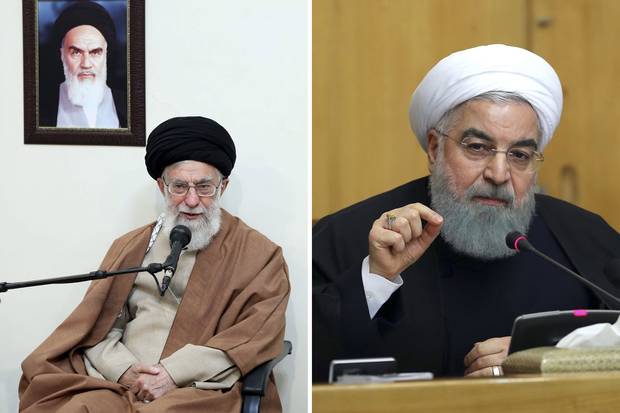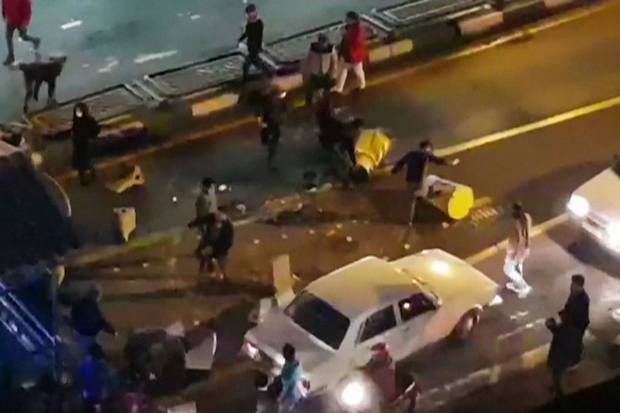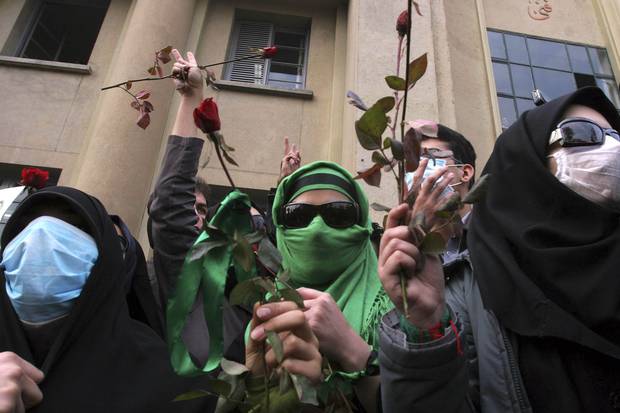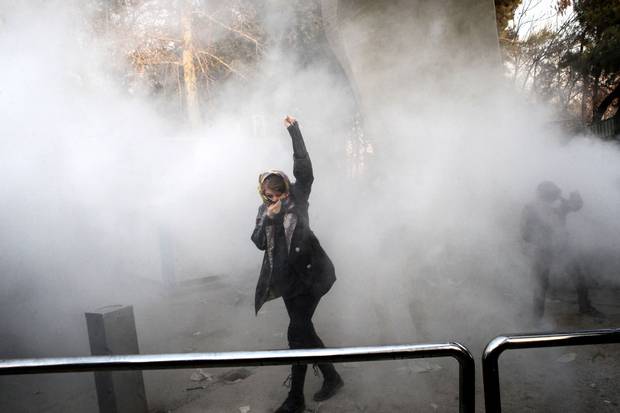On the ground
At least 21 people have been killed and hundreds arrested in Iran since Dec. 28, when nationwide protests over Iran's weak economy escalated into a large-scale confrontation with the Islamic republic's leadership, the largest since 2009. Here are some of the main takeaways from recent days:
- Monday and Tuesday: State TV reported nine people killed in clashes between protesters and security forces on Monday night. The report alleged that some rioters tried to storm a police station to steal weapons. It was the second-deadliest night of protests after Sunday night, when some 10 people were reported killed.
- Tuesday: Supreme Leader Ayatollah Ali Khamenei accused the “enemies of Iran” of meddling in the country’s affairs, his first comments since the protests began.
- Wednesday: Tens of thousands of Iranians staged counter-protests in support of the government, state media reported.
How this started
Discontent has been brewing for months as Iranians have failed to see the hoped-for economic benefits of a 2015 nuclear deal, which lifted many international sanctions and allowed the country to sell its oil abroad again. While economic indexes have improved under President Hassan Rouhani's government, unemployment has risen since last year and youth unemployment is high. An overwhelmingly youthful population is far more interested in jobs and change than in the Islamist idealism and anti-shah republicanism of the 1979 revolution that the old guard clings to.
The current demonstrations began Thursday in Mashhad, Iran's second-largest city. Their apparent cause was a recent increase in egg and poultry prices by as much as 40 per cent, which a government spokesman has blamed on a cull over avian flu fears. But Mashad is also conservative bastion and a stronghold of Ebrahim Raisi, a cleric who unsuccessfully challenged President Hassan Rouhani in last year's election. Analysts suggest conservatives began the protests there as a means to pressure Mr. Rouhani.
The protests in Mashhad rapidly spread throughout the rest of the country of 80 million people, mobilizing a disparate and so far leaderless group of causes. Some protesters have chanted against Mr. Rouhani as well as Supreme Leader Ayatollah Ali Khamenei. Some have criticized Iran's military support of Syrian President Bashar Assad, while others have praised the U.S.-backed Iranian shah, who fled into exile just before the 1979 Islamic Revolution and died of cancer the following year.
Iran protests grow, death toll mounts

Left: Iran’s Supreme Leader Ayatollah Ali Khamenei sits under a portrait of the late Iranian revolutionary founder Ayatollah Khomeini on Jan. 2, 2018.
Right: President Hassan Rouhani speaks in a cabinet meeting on Dec. 31, 2017.
OFFICE OF THE IRANIAN SUPREME LEADER AND IRANIAN PRESIDENCY OFFICE
A who's who
Here are some of the key people and institutions that run the theocratic Islamic Republic of Iran:
Ayatollah Ali Khamenei: Iran's Supreme Leader is the country's highest religious authority and head of state, and has the final say on all state matters.
President Hassan Rouhani: Iran's head of government, Mr. Rouhani is a relatively moderate cleric who has governed since 2013.
Guardian Council: A 12-member panel half selected by the supreme leader and half nominated by the judiciary and approved by parliament. The council approves all laws and all presidential and parliamentary candidates, barring anyone who challenges the political system itself or advocates dramatic reform.
Revolutionary Guard: A security force answering only to the Supreme Leader, the Revolutionary Guard routinely arrests dual nationals and foreigners, using them as pawns in international negotiations.
Basij: A volunteer security force under the Revolutionary Guard that helped carry out the 2009 crackdown. Members of the Basij have been reported in the streets amid the crackdown on the current protests.

Dec. 30, 2017: An image grab taken from a handout video released by Iran’s Mehr News agency reportedly shows a group of men pushing traffic barriers in a street in Tehran.
MEHR NEWS/AFP/GETTY IMAGES
The crackdown
Travel restrictions and moves by the government to shut down social media have limited the ability of journalists to cover the ongoing unrest. This is some of what we know so far:
- Arrests: Several hundred people reportedly have been arrested, though police say they’ve released many. Pictures published by semi-official Iranian news agencies have shown water cannons being used on protesters in Tehran.
- Police presence: Uniformed and plainclothes police are in the streets, as are motorcycle-riding members of the Basij.
- Social media: Iran says it temporarily shut down access to a mobile phone messaging app called Telegram and the photo-sharing app Instagram to “maintain peace,” limiting protesters’ ability to share images and publicize rallies. Facebook and Twitter are already banned.
But the government also faces a tough balancing act in suppressing the uprising without fuelling more anger. To ease concerns about the economy, the government backed down on plans to raise fuel prices and promised to increase cash handouts to the poor and create more jobs in coming years.

Dec. 7, 2009: Student supporters of opposition leader Mirhossein Mousavi hold red roses during protests in central Tehran, amid demonstrations to challenge a disputed presidential election.
YOUR VIEW/REUTERS
2009 vs. 2018
The last comparable wave of unrest in Iran was in 2009, when the "Green Movement" mobilized against hard-line President Mahmoud Ahmadinejad's re-election amid widespread allegations of voter fraud. But there are major differences between these protests and the ones nine years ago:
- Different leadership: Unlike the unrest in 2009, the latest protests appear to be more spontaneous without a clear leader. This may be a more dangerous scenario for authorities, because it means they cannot round up the figureheads, a solution that was employed in 2009.
- Where it’s happening: In 2009, demonstrations were focused in Iran’s main cities and provincial capitals, including Tehran, Tabriz, Isfahan and Shiraz. They swelled to throngs of hundreds of thousands on some days. In contrast, the past days’ fury has burst out mainly in mid-size cities and towns. The protests have been smaller – it’s hard to get credible numbers, but they seem to each be in the hundreds or, at most, several thousand – but they have swiftly erupted in far more places.
- Social media: The 2009 protests erupted just three years after Twitter was launched, and at the time, fewer than one million Iranians had smartphones. Social media did play a role in those demonstrations – when a 26-year-old woman was shot to death in Tehran, video of her wrenching last moments circulated widely on social media and inspired others to join the movement – but now, the reach of social media has been exponentially magnified. An estimated 48 million Iranians have smart phones, more than half the population. The popular messaging apps Telegram and WhatsApp have been a boon for organizers because they are encrypted, giving a degree of protection from state surveillance.
- Politics vs. economics: The 2009 protests were more specifically aimed at political corruption. But the recent protests’ economic focus could make them harder to suppress in a country that often portrays the 1979 revolution as an uprising by the poor against exploitation.
- Who they’re rebelling against: The protesters of 2018 quickly started chanting slogans directly against the Supreme Leader and denouncing the Islamic Republic itself – not just a call for reforms, but an open and outright rejection of the ruling system. This is a dramatic shift from 2009. Protesters then had major demands – they wanted Ahmadinejad’s re-election overturned, reformist leader Mir Hossein Mousavi installed as president, greater social freedoms and an end to the security forces’ tight oppression. But their demands largely stayed in the framework of existing politics.
Canada's response
In an e-mail Monday, a spokesman for Foreign Affairs Minister Chrystia Freeland, said Canada is "encouraged" by the Iranian protests but troubled by the deaths of demonstrators:
We call on the Iranian authorities to uphold and respect democratic and human rights. We are encouraged by the Iranian people who are bravely exercising their basic right to protest peacefully. Canada will continue to support the fundamental rights of the Iranians, including freedom of expression.
Ottawa suspended diplomatic relations with Iran in 2012 under the previous Harper administration and called Tehran the biggest threat to global security.
Trump's response
On Twitter, U.S. President Donald Trump has kept up a drumbeat in support of the anti-government protests in Iran:
Big protests in Iran. The people are finally getting wise as to how their money and wealth is being stolen and squandered on terrorism. Looks like they will not take it any longer. The USA is watching very closely for human rights violations!
— Donald J. Trump (@realDonaldTrump) December 31, 2017
The people of Iran are finally acting against the brutal and corrupt Iranian regime. All of the money that President Obama so foolishly gave them went into terrorism and into their “pockets.” The people have little food, big inflation and no human rights. The U.S. is watching!
— Donald J. Trump (@realDonaldTrump) January 2, 2018
While some Iranians have shared Mr. Trump's tweets, many distrust him because of his administration's tense relationship with Tehran. Mr. Trump has denounced the 2015 nuclear agreement brokered by his predecessor, Barack Obama, as the "worst deal ever," and has suggested that sanctions could be reimposed or new ones introduced. Mr. Trump must decide in mid-January if he wants to continue to waive energy sanctions on Iran, and failure to do so could blow the 2015 deal apart.
Iran was also one of the nations targeted by Mr. Trump's ban on U.S. travel by citizens of several Muslim-majority countries, as well as Venezuela and North Korea. The ban has made him very unpopular in Iran, where Iranians are now blocked from getting U.S. visas.
The world's response
Israel: Calling the protesters "brave" and "heroic," Israeli Prime Minister Benjamin Netanyahu said in a video posted to YouTube on Monday that the protesters sought freedom, justice and "the basic liberties that have been denied to them for decades." Israel considers Iran its greatest enemy, citing decades of hostile rhetoric by Iran's leaders, support for anti-Israel militant groups and its development of long-range missiles.
Europe: Leaders of several nations who helped broker the 2015 nuclear deal called for calm in Iran and deplored the loss of life.
- Britain: Foreign Secretary Boris Johnson issued a statement late Monday saying “there should be meaningful debate about the legitimate and important issues the protesters are raising and we look to the Iranian authorities to permit this.”
- Germany: Foreign Minister Sigmar Gabriel also said in a statement that “after the confrontation of the past days it is all the more important for all sides to refrain from violent action.”
- France: The French Foreign Ministry said Tuesday “the right to protest freely is a fundamental right,” and that human rights will be a top priority in France’s discussions with Iranian authorities in the coming weeks.
What could this mean for the Middle East?
If the protests continue and spread, they could be a game-changer in Shia Iran's proxy wars for control of the Middle East with its Sunni Muslim rival, Saudi Arabia. Many of the protesters have called question the wisdom of Iran's interventions in Syria and Iraq in a battle for influence with the Saudis. The country's financial support for Palestinians and the Lebanese Shia group Hezbollah have also angered Iranians who want their government to focus on domestic economic problems instead.
Associated Press, with reports from Reuters and Gloria Galloway
MORE FROM THE GLOBE AND MAIL


